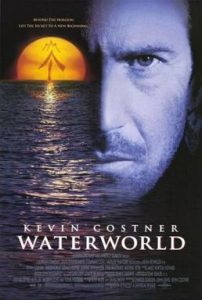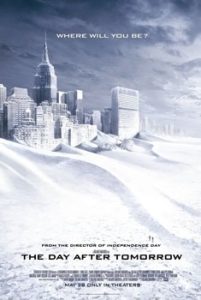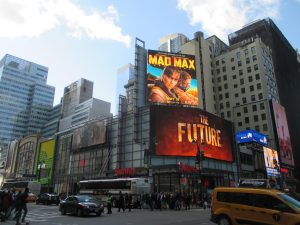5 Post-Climapocalyptic Dystopias
This is a difficult to module to write, because as I am doing so, in January 2023, California is experiencing a devastating weather event, likely caused by climate change. For the past two weeks, parts of the state have been overwhelmed by heavy rains caused by an atmospheric river. “[A] thin but long plume of moisture in the atmosphere that stretches from the tropics or subtropics into higher latitudes,” the current one stretches from Hawaii to the U.S. West Coast is commonly referred to as the “Pineapple Express.” But this current one is dumping unprecedented amounts of rain from the San Francisco Bay area to Los Angeles, from the coast inland to Sacramento, with Santa Cruz hardest hit so far. Flooding, mudslides, sinkholes, impassable roads, and the deaths of at least nineteen people so far have led President Biden to declare a major disaster in California.
Merriam-Webster defines dystopia as “an imagined world or society in which people lead wretched, dehumanized, fearful lives.” It is often opposed to a “utopia,” or an idealized state or society. Unfortunately, the California storms and the resulting devastation are all too real and seem eerily prescient to the post-climapocalyptic dystopia depicted in the 1995 film Waterworld, the first Hollywood film set in a world clearly destroyed by global warming.


For more information regarding copyright, see
https://en.wikipedia.org/wiki/File:Waterworld.jpg]
The most expensive film ever made at the time, Waterworld is set in 2500. The polar ice caps have melted, raising the oceans 25,000 feet and covering the Earth. A mythical “Dryland” seems out of reach. Humans struggle to survive in this world, adapting to living on boats and “atolls” of floating communities. The film’s anti-hero, The Mariner (Kevin Costner), not only has adapted more effectively than others through a variety of mechanized innovations on his boat, he has evolved, we discover, by growing gills and webbed feet. The Mariner arrives at an atoll to trade dirt, a rare commodity, which we later learn he recovered from the bottom of the ocean due to his unique ability to breathe underwater. At the atoll, he encounters a girl named Enola (Tina Majorino), who has a map to Dryland tattooed on her back, and her guardian, Helen (Jeannie Tripplehorn). A gang of pirates called “Smokers,” led by Deacon (Dennis Hopper), attack the atoll in pursuit of Enola and the secret her tattoo holds. Kevin, Enola, and Helen escape, and the anti-hero gradually evolves further into their protector, guardian them against further attacks by Deacon and others with nefarious intentions. Eventually he unlocks the map’s secret and leads them to Dryland (which is the top of a now-lush Mt. Everest). However, The Mariner ironically cannot share their new life there; having adapted to life on and in the water, he returns to his life wandering the oceans.
At the time of the film’s release, the press was largely silent on the ecological themes raised by its creators. Those themes likely were overshadowed by all the hype around the cost of the film, which was amplified by a number of cost “overruns” and significant production setbacks. Filmed primarily off the coast of Hawaii, Waterworld’s multimillion dollar atoll set pieces were destroyed by a hurricane, which had to be rebuilt. (Steven Spielberg had warned director Kevin Reynolds not to shoot on open water after his own struggles filming Jaws.) Costner also was injured while tied to the mast of his watercraft, the “trimaran,” when a squall hit during filming. Dissatisfaction with Mark Isham’s original music score, considered too bleak, led to the development of a new score by now-famed composer James Newton Howard, and script problems also led to the last-minute hiring of Joss Whedon for rewrites. And creative differences between Costner and Reynolds led the director to quit the film before its release. Considered the biggest box office bomb of all time after its domestic release, it did manage eventually to become profitable after release in foreign markets and to home video via VHS, Laser Disc (remember those?), DVD, Blu-ray, and streaming. It also spawned a wildly popular attraction, “Waterworld: A Live Sea War Spectacular,” at Universal Studios in Hollywood, Japan, and Singapore, generating billions in revenue.
Critically panned in 1995, reconsiderations of the film – and its themes – have been more favorable. The Guardian, in 2020, called it “a cult classic in the making.”[1] In 2009, Slate, upon the film’s release as a 2-disk extended edition dvd, suggested that it was an “eco-parable” ahead of its time.[2] Its depiction of the after effects of the melting of the polar ice caps, while likely significantly over-exaggerated based on current estimates of those potential impacts, is chilling and seems somewhat prescient. Waterworld opens with the Universal Studios logo morphing into an image of our planet being swallowed by blue while a narrator explains “The future: the polar ice caps have melted, covering the Earth with water.”
Although current science suggests that this would not be possible, the effects would still be devastating. Flooding of islands and coastal areas (with the Maldives predicted to be the first nation entirely under water as well as the Gulf Coast region of the U.S.) would force climate refugees to seek other homeland; many marine and land mammal species could be rendered extinct.[3] And the melting of the polar ice caps will accelerate global warming, which will, in turn, cause more rapid melting, one of the many feedback mechanisms that will accelerate abrupt climate change:
Snow and ice have long played a vital role in moderating Earth’s climate. The white surfaces reflect the sun’s radiation, which in turn helps maintain a comfortable temperature for life on the planet. But with a warming planet, that ice melts or thins, exposing the dark water below, which absorbs that radiation. So each year the global temperature rises, melting more ice and snow. It’s a positive feedback loop: warming causes ice melt, ice melt causes warming. And that process — also called Arctic amplification — leads to what we are observing now, which is a rapidly changing climate.[4]
After its chilling opening, Waterworld continues with our first glimpse of the Mariner, who is engaged in an act of recycling, using a homemade device that transforms his urine into potable water. He powers his trimaran through wind energy, although we come to find out that gas-guzzling watercraft still exist and are the preferred modes of transportation of Deacon and the Smokers. Staunchly anti-science and -sustainability, Deacon worships “Saint Joe” Hazelwood, infamous pilot of the Exxon Valdez and cause of the 1989 oil spill ecological disaster. He is obsessed with finding the mythical Dryland, which he plans to exploit for its resources as soon as he gets his hands on it: “If there’s a river we’ll dam it, and if there’s a tree we’ll ram it,” he declares. But the film may not have gone as some may have hoped for an eco-parable: it never explicitly claims that the flooding was human-caused, and it ends on a somewhat unfounded (but unsurprising for a “summer blockbuster”) note of hope in the lush landscape of dryland. For me, the hope is that Waterworld managed to open viewers’ eyes to the catastrophic possibilities of climate change. As David Zax in Slate argued, “… few things can make the future more vivid than a good science fiction movie.”[5]
Stephen Speilberg’s A.I. Artificial Intelligence (2001) is set in the 22nd century against a more realistic backdrop of the effects of global warming causing rising sea levels to wipe out coastal cities, reducing the world’s population. A plot centered around human-like robots programmed to love takes over from there, so that the environmental issues remain in the background. (Until the film’s end set two thousand years later when the earth is now buried under glacial ice and humans are extinct, replaced by androids.

[Image used under fair use.
For more information regarding copyright, see
https://en.wikipedia.org/wiki/File:The_Day_After_
Tomorrow_movie.jpg]
Three years later, a film considered by many to be at the apex of the Cli-Fi Dystopia films was released. The Day After Tomorrow (2004) depicts a series of fast developing, extreme weather events that usher in a new ice age across the Northern Hemisphere and devastating weather across the world, from tornadoes to tsunamis and hail storms. The main character is a scientist ignored by those in power – a relatively common trope in Cli-Fi Films. Here the scientist is Jack Hall (Dennis Quaid), a paleoclimatologist, someone who studies climates for which direct measurements were not taken. As Jack and his fellow scientists work to convince politicians, slow to take action, of the seriousness of the events and how to ensure the survival of affected populations, a subplot shows those effects on a small group – including Jack’s son, Sam (Jake Gyllenhaal) – stranded in the New York Public Library after a massive tsunami-like storm surge quickly inundates Manhattan.
Days later, the superstorms dissipate, but not after leaving many frozen to death. Sam survives and is rescued by his Dad, and after admitting his mistake in not acting sooner, the U.S. President orders all survivors evacuated to Mexico. The Day After Tomorrow ends with astronauts on the International Space Station looking down at Earth’s transformed surface, its ice sheets extending across much of the Northern Hemisphere – and its unprecedentedly clear air, ostensibly from the dissolution of human-caused pollution (not unlike what happened in many locations during the COVID-19 pandemic):
Directed by Roland Emmerich, the film was based on the book The Coming Global Superstorm (1999) by Art Bell and Whitley Strieber, which warns that global warming might produce sudden and catastrophic climate change. Although a box office success, critics were mostly lukewarm, praising the special effects but dismissing The Day After Tomorrow as a popcorn thriller. Roger Ebert of the Chicago Sun-Times described the film as “profoundly silly.”[6] Scientists were equally dismissive due to the film’s inaccuracies, especially depicting meteorological phenomena as occurring over the course of hours, instead of decades or centuries. For example, J. Marshall Shepherd, a research meteorologist at the NASA Goddard Space Flight Center, gave the film his own rating: “”I’m heartened that there’s a movie addressing real climate issues. But as for the science of the movie, I’d give it a D minus or an F.”[7] But at least one scientist emphasized the potential benefits of blockbuster Cli-Fi Films like The Day After Tomorrow. Stefan Rahmstorf of the Potsdam Institute for Climate Impact Research argued:
Clearly this is a disaster movie and not a scientific documentary, [and] the film makers have taken a lot of artistic license. But the film presents an opportunity to explain that some of the basic background is right: humans are indeed increasingly changing the climate and this is quite a dangerous experiment, including some risk of abrupt and unforeseen changes.[8]
In contrast to the splashy special effects and summer blockbuster-esque nature of Emmerich’s film, The Road (2009) has more of an indie-feel, with its more pared-down and often harsh, “realistic” portrayal of a post-apocalyptic world. In fact, Tom Huddleston from Time Out called the film “the bleakest and potentially the least commercial product in recent Hollywood history.” Based on the Pulitzer Prize-winning Cormac McCarthy novel of the same name, the film never explains the nature of the near-extinction event from which the two main characters, Man (Viggo Mortensen) and Boy (Kodi Smit-McPhee) struggle to survive. Like Waterworld, the film does not dwell on what caused the current environment and society; unlike Waterworld, the journey on the eponymous road does not lead to some mythical or imagined better place. Emmerich (like McCarthy) is focused on the day-to-day fight to survive dire, often deadly, circumstances.[9] It’s a chilling, effective portrayal of survival in a hostile world like (or that is) a post-climapocalyptic dystopia, the bleakness of which is clear in this trailer:
Two years later, Emmerich produced an explicitly (and equally bleak) post-climapocaylpse film, Hell. In 2016 Germany, global temperatures have risen by ten degrees Celsius. Crops have failed, little water or food is available, and social order has broken down. The sun is so hot that traveling outside during daylight hours is dangerous. Hell’s characters, driving in a car covered in cardboard for shade except a small sliver on the driver’s side, face numerous threats as they drive to the mountains where water is rumored to remain. The final threat they face mirrors one of the obstacles depicted in The Road: humans captured so that others can feed on their flesh. In both films, cannibalism, widely considered taboo in modern society, represents the deepest depths to which humans will descend in the face of extreme natural disasters like those that may be caused by climate change. The film – including its title – is far from original or subtle, but creators, like Emmerich, of Cli-Fi films may have felt that the time for subtlety depicted in films like FernGully or even Avatar may have passed.
The Colony (2013) is a Canadian film directed by Jeff Renfroe and starring Laurence Fishburne, Kevin Zegers, and Bill Paxton. It is a rather forgettable movie; Rotten Tomatoes gives the film a score of 18% based on reviews from 33 critics, and a rating average of 4 out of 10.[10] However, in the canon of Cli-Fi films it is somewhat unique: it opens with a depiction of efforts to mitigate the effects of climate change. Set in the near future of 2024, humans constructed climate modification towers to control the warming, but the machines break down, causing the climate to shift to the other extreme. When it begins to snow and does not stop, the remaining humans live in underground bunkers facing such challenges as controlling disease and producing sufficient food. This, in term, leads to a familiar additional challenge: cannibalism.
The next year brought the release of one of my all-time favorite Cli-Fi Films: Snowpiercer. I saw it when it opened in theatres (at my local Alamo Drafthouse) and was, frankly, blown away by its taut storyline, setting-all-in-one-train, dark cinematography, the performances of actors Chris Evans, Tilda Swinton, Ed Harris, Octavia Spencer, and others, and Boon Joon-ho’s direction (he later won an Oscar for Parasite; see Scene 6: Psychological Thrillers in this text). And it happens, like The Colony, to open in a world where attempts to address the effects of climate change have failed.

‘Snowpiercer/Le Transperceneige'” by Centre Culturel Coréen
is licensed under CC BY-NC-ND 2.0.
Based on a French graphic novel series, Snowpiercer is set, somewhat alarmingly, in the very near future of 2031. 17 years earlier, an attempt to stop global warming by injecting aerosols into the atmosphere to cause a dimming/cooling effect catastrophically backfires and creates a new ice age. A small number of survivors live in a self-contained, self-sustaining train that repeatedly circumnavigates the globe. However, segregation and social stratification divides the train into near-starving “have-nots” in the back and the well-fed elite toward the front, fomenting a rebellion by those in the rear. Led by Curtis Everett (Chris Evans) and his second-in-command, Edgar (Jamie Bell), a small band fights their way to the front, encountering violent resistance and scenes of relative normalcy and even shocking opulence. I’ll avoid giving away the ending on this one and instead encourage you to screen the film asap — surely this exciting trailer will inspire you to do so:
Snowpiercer draws on some common tropes and themes of previous Cli-Fi Films (an anti-hero turned hero and younger “sidekick,” revelations of shocking food sources, exploitation of children, and the like). A. O. Scott of The New York Times wrote about the film, “Planetary destruction and human extinction happen a half-dozen times [on film] every summer. It’s rarely this refreshing, though.”[11] Indeed, the movie is fairly unique in its setting on a single train, often dark and claustrophobic but with occasional bursts of blinding light reflected off the frozen earth of which we occasionally catch glimpses through windows. Joon-ho takes full advantage of that setting, creating an on-the-edge-of-your-seat tension as the viewer wonders what awaits the rebels through the next door as they fight their way from car to car to the front of the often visually stunning train.

Like Scott, reviewers were largely positive, often glowing. Chris Nashawaty of Entertainment Weekly gave the piece an “A” rating, stating, “Snowpiercer sucks you into its strange, brave new world so completely, it leaves you with the all-too-rare sensation that you’ve just witnessed something you’ve never seen before … and need to see again.”[12] Joshua Rothkopf of Time Out New York scored the film five out of five stars, calling it a “headlong rush into conceptual lunacy—but you’ll love it anyway.”[13] A popular reboot as a tv series, with events on the train starting about seven years after the global catastrophe, premiered in 2020. And the film became a favorite for many climate activists besides me. One article by a climate journalist read, “‘Snowpiercer’: If You Care About Climate Change, This Sci Fi Thriller Is For You.” In it, author Kate Aronoff suggests that the point of the film “is how interconnected the climate crisis is to the logic of capitalism, and how wary we should be of solutions that stem from it,” adding that “[c]onfronting the climate crisis means confronting capitalism and the inequality it produces: It’s literally impossible to do one without the other—so do it right.”[14]
Snowpiercer’s depiction of geoengineering gone array apparently is not realistic; MIT scientists argue that such accidental effects are unlikely. With geoengineering, humans would deliberately try to cool the Earth, to counter the warming we’re causing. There are potential unintended, harmful consequences, though, including environmental – such as shifting rain patterns, affecting crops and vulnerable species. And social consequences could include conflicts over control of such interventions and individual nations making choices that could affect the entire planet.[15]
That same year, Interstellar (2014) premiered, taking as its starting point a devastated world, but it never directly mentions climate change as the cause. Written and directed by Christopher Nolan, the film is set in 2067 when the Earth is on the verge of total ecological collapse, with drastic changes in weather patterns and devastating food shortages driving human beings to the brink of extinction. We never learn exactly what caused this (there is a vague reference to a crop disease called “a blight”). But it seems clearly human-caused or exacerbated, and ex-NASA pilot Joseph Cooper (Matthew McConaughey) goes on a quest to find a planet capable of supporting human life, later taken up by his daughter (Jessica Chastain). It is an optimistic, often majestic, film, but like virtually all Cli-Fi Films, it fails to offer any realistic, viable solutions, with the two choices being to die on Earth or find another planet to escape to. In spite of the note of optimism at the end – another scientist, Amelia (Anne Hathaway), is seen setting up a colony on a viable planet – we can’t help but wonder if humans will destroy this one too.
The post-climapocalyptic desert wasteland in Mad Max: Fury Road (2015 – and another favorite of mine) is an imagined future that is opposite from the flooded planet of Waterworld or the arctic planet of The Day After Tomorrow or Snowpiercer. The movie, which like Interstellar never explicitly mentions climate change, nevertheless centers on a common trope in Cli-Fi Films: control of limited resources (fuel, water, food, etc.) which always leads to conflict. As argued by Judith Eckenhoff in “The Desert Wasteland and Climate Change in Mad Max: Fury Road,” “[I]t is a critique of the capitalist greed, continued reliance on fossil fuels, and increasing resource scarcity that are at the core of the discourse surrounding climate change.”[16]

Fury Road is the fourth installment in George Miller’s series of Mad Max films, begun in 1979 with Mel Gibson as the antihero Max Rockatansky. Recasting Tom Hardy in the titular role, the movie opens with Max getting captured by the War Boys, the followers of the warlord Immortan Joe (Hugh Keays-Byrne). Max is imprisoned in Joe’s fortress, The Citadel, and used as a human “blood bag” for the diseased Boys, including Nux (Nicholas Hoult). From the Citadel, Immortan Joe controls the water supply, dispensing it at intervals to the desperate locals gathered below. Meanwhile, battle-worn Imperator Furiosa (Charlize Theron), one of Joe’s lieutenants, helps his five enslaved “wives” escape their own imprisonment in The Citadel. Joe and the War Boys pursue in elaborate, gas-guzzling vehicles, Max strapped to the front of Nuz’s. When Max manages to free himself after a crash, he reluctantly forges an alliance with Furiosa and the women. When it becomes clear that their destination, the storied “Green Place,” is now a wasteland as well, the women decide to turn back and, with Max’s (and Nux’s, who sacrifices himself) help, Kill Joe and take control of the Citadel. At the end, Max exchanges a respectful look with Furiosa and disappears wordlessly into the crowd.
Hopefully, that scene conveys a sense of the stunning, elaborate set pieces, costume and makeup, and overall cinematography and sound of Fury Road. Like Snowpiercer, I saw the film when it opened in 2015 at my local Alamo Drafthouse, and I was – to put it colloquially – blown away. Many critics were (rightfully, in my opinion) ecstatic, some even calling it the greatest action film of all time. Robbie Collin of The Daily Telegraph gave the film a full five stars and praised its acting, screenplay, choreography, stunts, humor, and direction, describing it as a “Krakatoan eruption of craziness.”[17] Lindsay Bahr of the Associated Press described the film as “radically visionary.” IGN reviewer Scott Collura gave the film a 9.2 out of 10, writing: “the over-the-top stunts and eccentric characters and designs are all hugely important to Fury Road, as are the troubled figures like Max himself and Furiosa, but it’s the overriding sense of the film’s uniqueness, its striving to be something more than just another action movie, that is most impressive.”As Dan Hassler-Forest in Science Fiction Film & Television put it, no other film “has made the post-apocalyptic, warlord-ravaged hellscape that seems like the inevitable end game of global capitalism so much fun.”[18]

A significant difference between Fury Road and Cli-Fi films that came before is its strong feminist perspective, with Furiosa the protagonist as much as, if not more than, the titular antihero Max. The female characters’ drive not just to survive their current circumstances but to escape to a better life is at the heart of the film and the reason for the journey on the titular road. It is their fury, more than Max’s, that we feel, their strength that we applaud and within which we revel. While Max and Nux assist, it is Furiosa and the women she leads who rebel against and end the violent regime of the post-capitalist, patriarchal villain Joe. Taylor Boulware writes that Fury Road “is utopian, not in the sense that it presents an ideal world, but that it imagines successful liberatory revolution and the destruction of decrepit systems of oppression, out of which a more perfect, egalitarian world can then emerge.”[19] The sustainability that the film’s end implies is grounded in taking responsibility for one’s actions, solving real-world, current challenges, and not seeking escape in some idealized elsewhere. It’s the closest to actual solutions to the challenges of human-induced climate change that a Cli-Fi film had produced up to that point.
Does the filmmakers’ reliance on the tropes of hyper-masculinity – brutal violence, souped-up car culture, spectacular explosions, heavy metal, and the like – undermine its feminist messages and vision for a post-capitalist, post-climapocalyptic dystopia? Perhaps, but in the opinion of this viewer, these make for one heck of a ride and for other viewers perhaps made the metaphoric spoonful of medicine more digestible, even appealing. Again, like movies like Avatar and The Day After Tomorrow, the blockbuster effect of Fury Road to potentially shift attitudes toward climate change should not be underestimated.

KNOWLEDGE CHECK
Videos
Opening Scene of ‘Waterworld’: https://youtu.be/Kd7rScF8tIs
The Day After Tomorrow — Ending Scene: https://youtu.be/WcQC1c-53uA
Mad Max Fury Road – Ending Scene: https://youtu.be/rA0jO_FuNag
- Child, Ben (July 13, 2020). "Waterworld: is Kevin Costner's damp squib a cult classic in the making?" The Guardian. Retrieved January 19, 2023. ↵
- Zax, David (February 3, 2009). Return to Waterworld. Slate. Retrieved Jan 23, 2023. ↵
- Climate Change Guide. Melting Polar Ice Caps. Retrieved January 23, 2023. ↵
- Mortilarro, Nicole (Sep 25, 2019). What an ice-free Arctic really means, and why it matters so much. CBC News. Retrieved January 23, 2023. ↵
- Zax, David (February 3, 2009). Return to Waterworld. Slate. Retrieved Jan 23, 2023. ↵
- Ebert, Roger (May 28, 2004). "The Day After Tomorrow Movie Review." Chicago Sun-Times. Retrieved January 24, 2023. ↵
- Bowles, Scott (May 26, 2004). "'The Day After Tomorrow' heats up a political debate Storm of opinion rains down on merits of disaster movie." USA Today. Retrieved January 24, 2023. ↵
- Rahmstorf, Stefan. "The Day After Tomorrow—Some comments on the movie." Potsdam Institute for Climate Impact Research. Archived from the original on October 11, 2004. Retrieved January 24, 2023. ↵
- "The Road (2010), directed by John Hillcoat | Film review." Timeout.com. Retrieved January 25, 2003. ↵
- "The Colony (2013)." Rotten Tomatoes. Retrieved January 26, 2023. ↵
- "Stuck in Steerage for the Postapocalypse." The New York Times. 26 June 2014. Retrieved January 30,2023. ↵
- "Snowpiercer." Entertainment Weekly. 9 July 2014. Archived from the original on 27 June 2014. Retrieved January 30, 2023. ↵
- "Snowpiercer." Time Out New York. 24 June 2014. Archived from the original on 28 June 2014. Retrieved January 30, 2023. ↵
- Aronoff, Kate (July 8, 2014). “Snowpiercer”: If You Care About Climate Change, This Sci Fi Thriller Is For You.” Yes! Solutions Journalism, reprinted from Waging Nonviolence. Retrieved January 30, 2023. ↵
- Kong, Bliss, and MacMartin, Douglas (January 26, 2021). Could Snowpiercer actually happen? Ask MIT Climate, Retrieved January 30, 2023. ↵
- Eckenhoff, Judith (2015). ↵
- Collin, Robbie (11 May 2015). "Mad Max: Fury Road review: 'a Krakatoan eruption of craziness.'" The Daily Telegraph. UK. Archived from the original on 20 July 2017. Retrieved February 2, 2023. ↵
- Hassler-Forest, Dan (2017) “Mad Max: Between Apocalypse and Utopia,” Science Fiction Film & Television 10.3, p. 301. ↵
- Boulware, Taylor (2016). “‘Who Killed the World’: Building a Feminist Utopia from the Ashes of Toxic Masculinity in Mad Max: Fury Road,” Mise-en-scène: The Journal of Film & Visual Narration 1.1, p. 1. ↵
